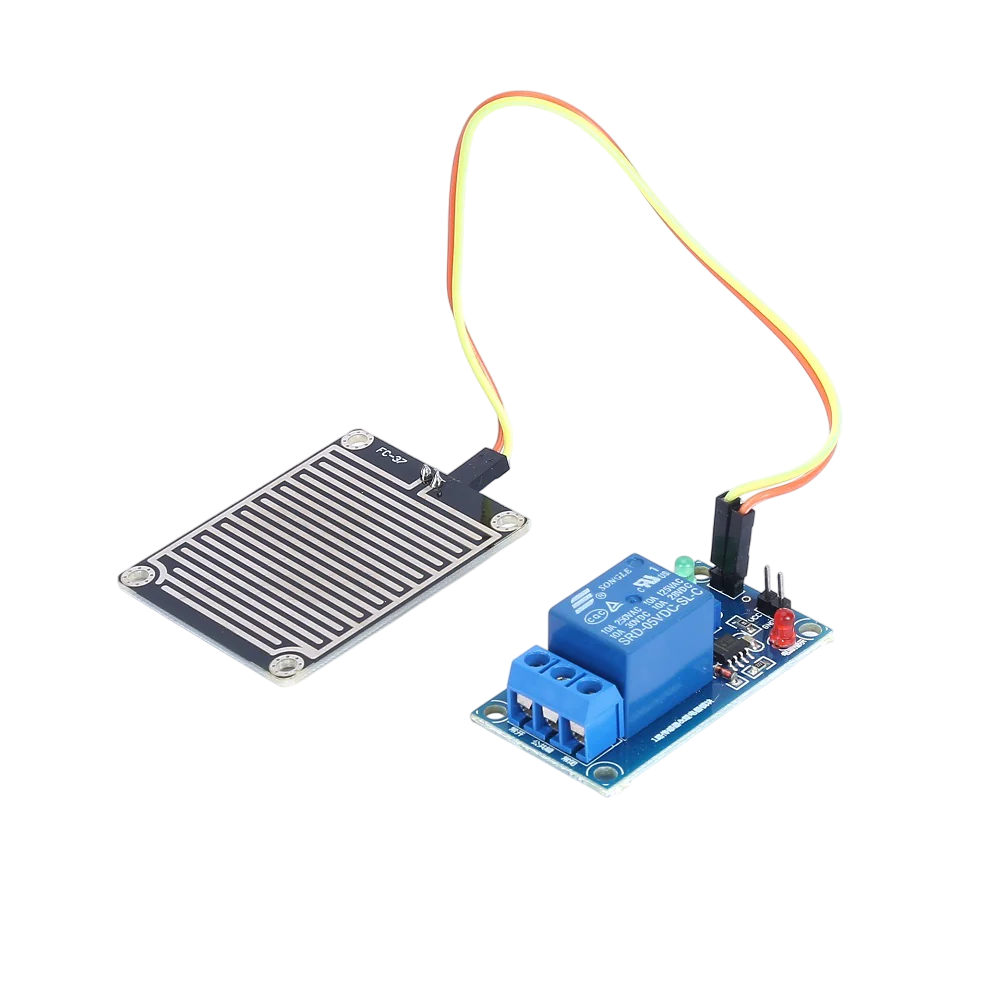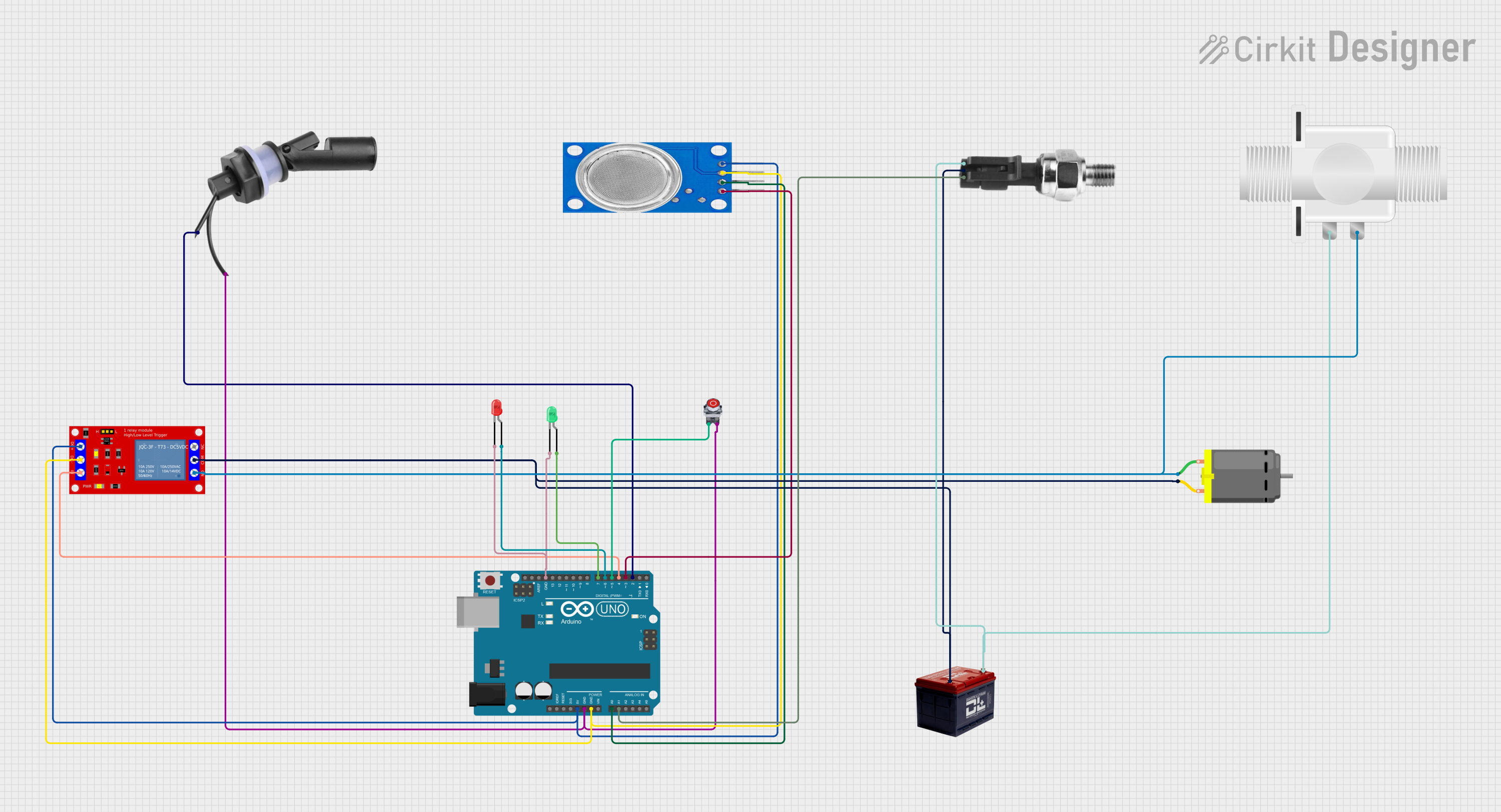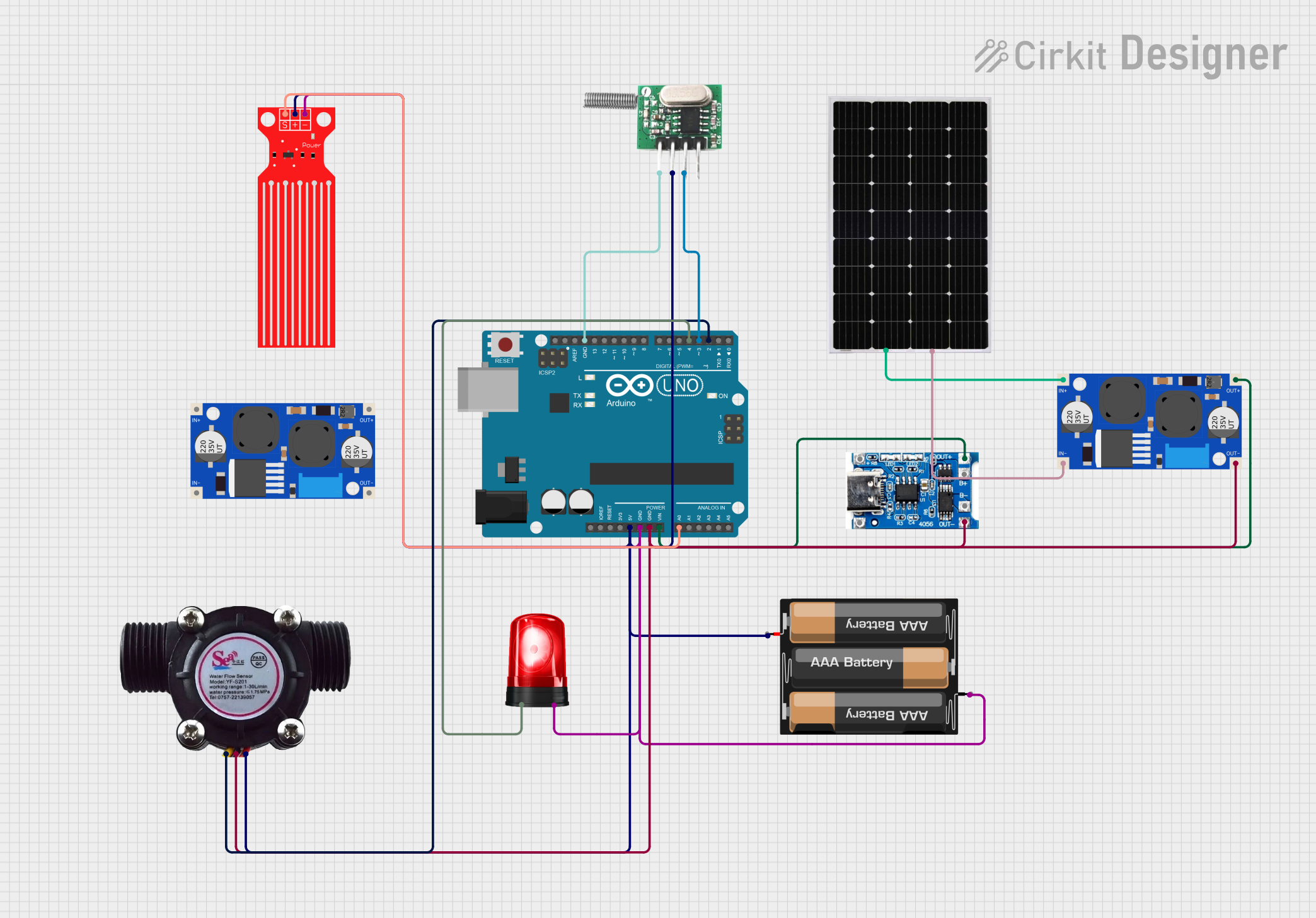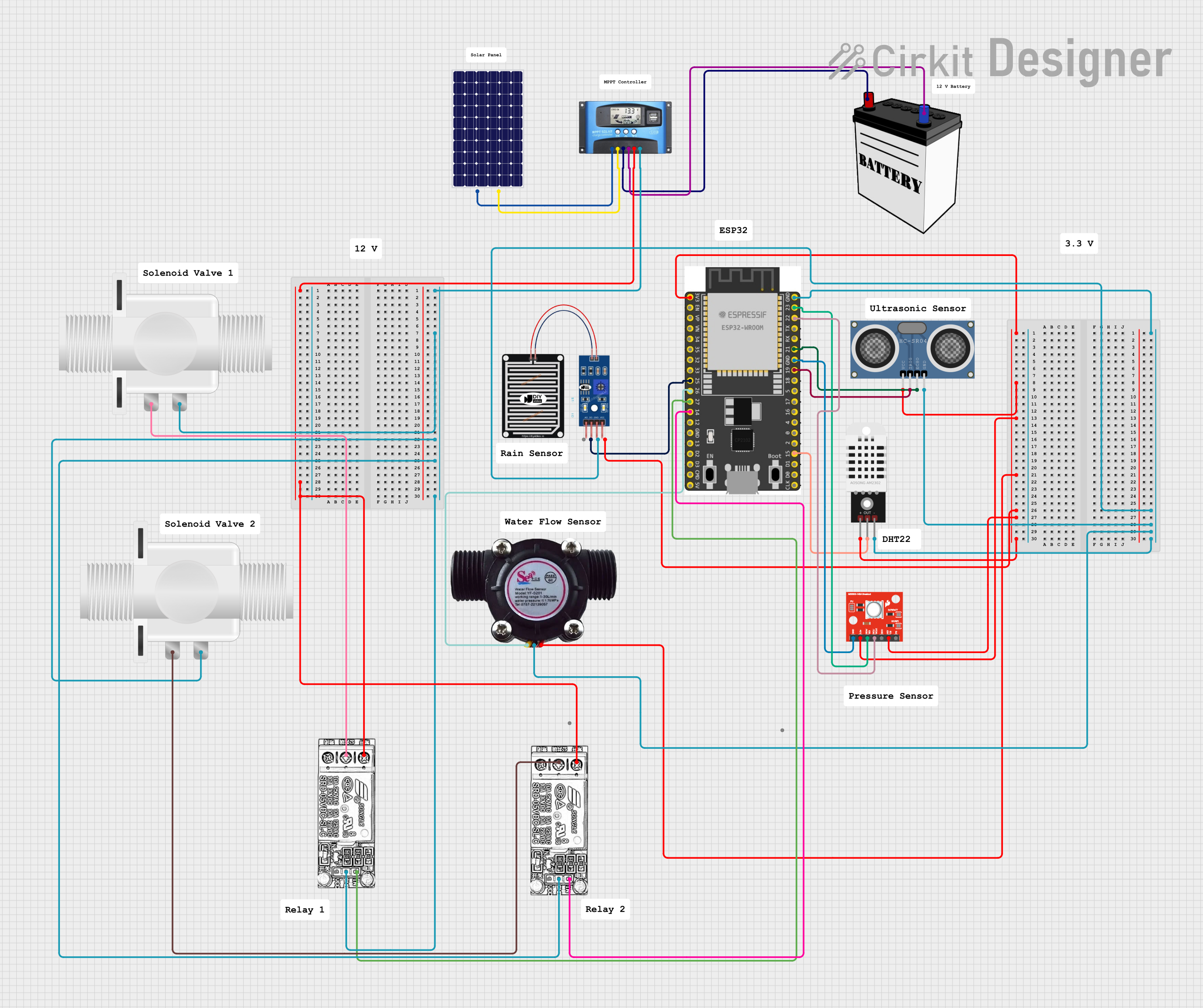
How to Use RAIN WATER SENSOR MODULE 12V: Examples, Pinouts, and Specs

 Design with RAIN WATER SENSOR MODULE 12V in Cirkit Designer
Design with RAIN WATER SENSOR MODULE 12V in Cirkit DesignerIntroduction
The Rain Water Sensor Module 12V is a versatile electronic component designed to detect the presence of rainwater. It operates at a standard 12V input and provides an easy way to monitor environmental conditions. The module typically consists of a rain detection board and a control board, which work together to sense water droplets and output a corresponding signal.
Explore Projects Built with RAIN WATER SENSOR MODULE 12V

 Open Project in Cirkit Designer
Open Project in Cirkit Designer
 Open Project in Cirkit Designer
Open Project in Cirkit Designer
 Open Project in Cirkit Designer
Open Project in Cirkit Designer
 Open Project in Cirkit Designer
Open Project in Cirkit DesignerExplore Projects Built with RAIN WATER SENSOR MODULE 12V

 Open Project in Cirkit Designer
Open Project in Cirkit Designer
 Open Project in Cirkit Designer
Open Project in Cirkit Designer
 Open Project in Cirkit Designer
Open Project in Cirkit Designer
 Open Project in Cirkit Designer
Open Project in Cirkit DesignerCommon Applications and Use Cases
- Automatic irrigation systems for agriculture or gardening
- Weather monitoring and rain detection systems
- Smart home automation (e.g., closing windows during rain)
- Water leakage detection in industrial or residential setups
Technical Specifications
Below are the key technical details of the Rain Water Sensor Module 12V:
| Parameter | Specification |
|---|---|
| Operating Voltage | 12V DC |
| Output Signal | Digital (High/Low) and Analog (0-5V) |
| Detection Area | ~5cm x 4cm (rain detection board) |
| Sensitivity Adjustment | Potentiometer on the control board |
| Output Type | Digital: TTL logic, Analog: Voltage |
| Dimensions | ~3.2cm x 1.4cm (control board) |
| Operating Temperature | -40°C to 85°C |
Pin Configuration and Descriptions
The Rain Water Sensor Module has the following pin configuration:
Control Board Pinout
| Pin Name | Description |
|---|---|
| VCC | Power supply input (12V DC) |
| GND | Ground connection |
| D0 | Digital output (High when no rain, Low when rain detected) |
| A0 | Analog output (Voltage proportional to water level) |
Rain Detection Board Connection
| Pin Name | Description |
|---|---|
| S | Signal pin (connects to control board) |
| + | Positive power input (connects to control board) |
| - | Ground connection (connects to control board) |
Usage Instructions
How to Use the Component in a Circuit
- Power the Module: Connect the VCC pin to a 12V DC power source and the GND pin to the ground.
- Connect Outputs:
- For digital output, connect the D0 pin to a microcontroller or logic circuit.
- For analog output, connect the A0 pin to an ADC (Analog-to-Digital Converter) pin of a microcontroller.
- Rain Detection Board: Attach the rain detection board to the control board using the provided pins (S, +, -).
- Adjust Sensitivity: Use the potentiometer on the control board to adjust the sensitivity of the digital output.
Important Considerations and Best Practices
- Placement: Ensure the rain detection board is placed in an open area where it can directly come into contact with rainwater.
- Waterproofing: Protect the control board from water exposure to prevent damage.
- Signal Stability: Use pull-up or pull-down resistors if necessary to stabilize the digital output signal.
- Power Supply: Use a regulated 12V DC power source to avoid damage to the module.
Example: Connecting to an Arduino UNO
Below is an example of how to connect the Rain Water Sensor Module to an Arduino UNO and read its output:
Circuit Connections
- Connect the module's VCC to the Arduino's 5V pin (if using a 5V version of the module) or an external 12V power supply.
- Connect the GND pin to the Arduino's GND.
- Connect the D0 pin to Arduino digital pin 2.
- Connect the A0 pin to Arduino analog pin A0.
Arduino Code
// Define pin connections
const int digitalPin = 2; // Digital output from the sensor
const int analogPin = A0; // Analog output from the sensor
void setup() {
// Initialize serial communication for debugging
Serial.begin(9600);
// Set the digital pin as input
pinMode(digitalPin, INPUT);
}
void loop() {
// Read the digital output (High = no rain, Low = rain detected)
int digitalValue = digitalRead(digitalPin);
// Read the analog output (proportional to water level)
int analogValue = analogRead(analogPin);
// Print the values to the Serial Monitor
Serial.print("Digital Output: ");
Serial.println(digitalValue);
Serial.print("Analog Output: ");
Serial.println(analogValue);
// Add a small delay for stability
delay(500);
}
Troubleshooting and FAQs
Common Issues and Solutions
No Output Signal:
- Ensure the module is powered with the correct voltage (12V DC).
- Check all connections, especially between the rain detection board and the control board.
- Verify that the rain detection board is exposed to water droplets.
Unstable Digital Output:
- Adjust the sensitivity using the potentiometer on the control board.
- Use a pull-up or pull-down resistor to stabilize the signal.
Analog Output Not Changing:
- Ensure the rain detection board is clean and free of debris.
- Verify that the analog pin is correctly connected to the microcontroller.
FAQs
Q: Can this module detect the intensity of rain?
A: Yes, the analog output (A0) provides a voltage proportional to the amount of water on the detection board, which can be used to estimate rain intensity.
Q: Is the module waterproof?
A: The rain detection board is designed to be water-resistant, but the control board must be protected from water exposure.
Q: Can I use this module with a 5V power supply?
A: Some versions of the module support 5V operation. Check the specific model's datasheet to confirm compatibility.